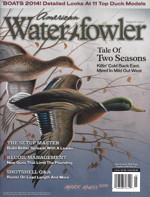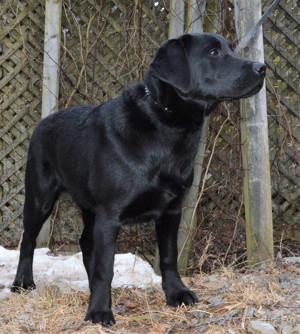There is an Elephant in the Room
by Robert Milner
I get a lot of phone calls from hunters seeking gundogs. Most of the phone calls begin with the statement. "I am looking for a hunting dog, not a field trial dog." That is a good sign. The American hunter is becoming much more aware that good field trials dogs frequently make poor hunting dogs. The population of field trial dogs contains far too many dogs that are high in reactivity and low in impulse control. This makes a dog that is difficult to train and difficult for the average guy to keep under control. They are a lot of work. I am going to give you a tale of just two dogs who have contributed their genetic traits both good and bad to the gene pool of field trial retrievers. Many other dogs with similar traits continue to contribute to that gene pool as well. This is a tale of two retriever gundog faults that have become widespread. The faults are whining in the geblind and inability to sit still in the duckblind. The spread of these faults is a signal that our retriever competitions are failing at their job of guiding breeding selection to produce excellent gundogs.
I have been conducting an informal survey for the past few years. At I every retriever seminar I conduct, and whenever I am thrown together with waterfowlers, I ask "How many of you are duck hunters?" Then I ask, "How many of you have been in a duck blind with a whining dog?". The resulting response is nearly 100% of duck hunters have been in a blind with a whining dog. That is absolutely astounding. 30 years ago you never saw a Labrador that was an excitement whiner. Today, obviously there are many excitement whiners in the duckdog ranks. Genetics is involved with excitement whining. A lot of today's whiners probably have in their pedigrees a particular sire that was a National Amateur Field Trial winner in the early 70s. This dog had been fairly noisy on shot flyers in his youth, and some fairly strenuous training was required to suppress it. It was suppressed sufficiently to only occur a little bit every once in a while in a field trial. The dog only occasionally voiced a small whine, which field trial judges forgave because the dog had so much style as expressed by his moving fast and hard on a retrieve. Since field trial titles drive breeding selection and national field trial titles put it in overdrive, the whining dog was bred a good bit. You can suppress an individual dog's behavior, but that does not suppress the inheritance of the trait by his puppies. Because of the stature involved, a national field trial winning sire will be bred quite frequently, and he will produce a large number of puppies that carry his genetic makeup, including the propensity to whine when excited.
Another common retriever gundog fault is an inability to sit still in a high temptation environment. When guns start shooting and birds start falling, this dog starts bouncing and can't sit still. In field trial dogs this is typically manifested as creeping. When the shooting starts and the birds are falling the dog starts bouncing and creeping forward. One of the best creepers that I have ever seen won a National Amateur Field Trial in the early 70s.
The professional trainers customarily serve as bird throwers at the National Amateur. The year in question, I was throwing birds and thus watched every dog run. The dog in question I will call "Creeper" to protect the guilty. "Creeper" was a quite talented dog. Every time a bird was thrown he would creep out 10 feet from the handler. When the bird reached the top of its arc, "Creeper" would turn unbidden and zip back to heel, while marking the bird's fall over his shoulder. If it was a triple, where three birds are thown sequentially at three different locations, "Creeper" would sequentially zip 10 feet out and return unbidden to the handler three times, sequentially, like a yoyo.
"Creeper" won the National Amateur that year. Obviously the judges gave little heed to the creeping. They probably forgave the creeping because the dog had so much style. He charged out with great effort and speed and accuracy, and excelled at the tests that the judges had set up. They forgave the creeping for the sake of "style". However, by condoning the creeping they did a disservice to the gundog world. When a dog gets to the national level of competition, you can bet that money and effort and training have not been spared in trying to smooth out any behavioral issues. If the creeping could have been suppressed by training, it would have been. Thus one can assume that there was a significant genetic component to "Creeper's"creeping. Being a National Amateur Field Champion, Creeper was bred a lot. He produced a lot of puppies. A significant percentage of those puppies had a strong tendency to creep.
Both whining and creeping are symptoms of an underlying behavioral makeup. They are both symptoms of a dog who is high in reactivity and low in impulse control. Such dog does well at field trial work where excellence is based upon the principle of the dog taking the energy expensive route on a retrieve. Such a dog is also probable of being difficult to train. The hunter needs a dog that is low in reactivity and high in impulse control. That dog will be easy to train, easy to live with and pleasant to have in the duck blind.
Over the last thirty years the dog that is high in reactivity and low in impulse control has spread prolifically in the field Labrador gene pool. To gain a perspective on how fast a genetic behavioral trait can spread one only need look at the Silver Fox Tameness Research Project conducted in the sixties by the Russian geneticist Dmitry K. Belyaev. In Russia there are a number of farms raising wild foxes in large pens for the fur industry. Belyaev went to a Silver Fox raising farm and conducted a breeding selection research project. He went through the farm and selected a number of foxes. His selection was based upon each fox's tolerance of people. He selected foxes that tolerated a close approach by a human. He then bred these "close approach" foxes with each other. These pairings produced first generation offspring that tolerated being touched by humans. The breeding according to greater affinity for people continued. By the fifth generation the pups were friendly toward experimenters, wagging their tails and whining. In the sixth generation bred for tameness they produced some fox pups that were eager to establish human contact. The fox puppies whimpered to attract attention and sniffed and licked the experimenters, just like dog puppies. The experimenters termed this behavior category as "domesticated elite". By the 10th generation, 20% of the experimenters' breeding population was "domesticated elite".
The Silver Fox experiment is a great example of how fast breeding selection can change major behavioral traits. It took only 10 years to go from a population consisting of 100% extremely wild foxes to a population of foxes that were mostly tame with 20% of the population extremely tame. Looking at the field trial gene pool of Labradors, one can say that in the 1950s and 1960s most of the field trial dogs were fairly calm. They were low in reactivity and high in impulse control. Then as the amateurs judging field trials began to change their standards, and began to allow creepers and whiners to win field trial titles, the gene pool began changing. More titles went to dogs high in reactivity and low in impulse control. Those titles also went on pedigrees, and people used those pedigrees to select breeding candidates. We have been pursuing this course for 40 or 50 years now. What per cent of Labradors in the field trial gene pool now are high in reactivity and low in impulse control?
An elephant is said to be in the room when there is present an important and obvious topic, which everyone is aware of, but which isn’t discussed, as such discussion is considered to be uncomfortable.
With respect to the field trial Labrador gene pool, there is an elephant in the room. The elephant's name is “style” or “drive” or straight line. When you next want to select a gundog puppy you would be well served to look behind the elephant. Look past the pedigrees and personally meet the puppy's parents. If the parents don't behave the way you would want, then the puppy is unlikely to behave the way you will want. Field trials have failed at driving breeding selection to produce better gundogs.
Robert Milber has trained more than 2000 dogs since he began working with retrievers in 1972. He Founded Wildrose Kennel in that year and sold it in 1995. He currently owns and operates Duck Hill Kennels, breeding and Training British Labradors
by Robert Milner
Article posted with permission
Sources: Robert Milner and American Waterfowler
I am a breeder/trainer of Labrador Retrievers with 50 years experience. This article exactly reflects my opinions and experience. The general hunting public deserve to be protected against the notion that field trial dogs are the best choice for hunters.
Don BATES, Doindogs Kennel




